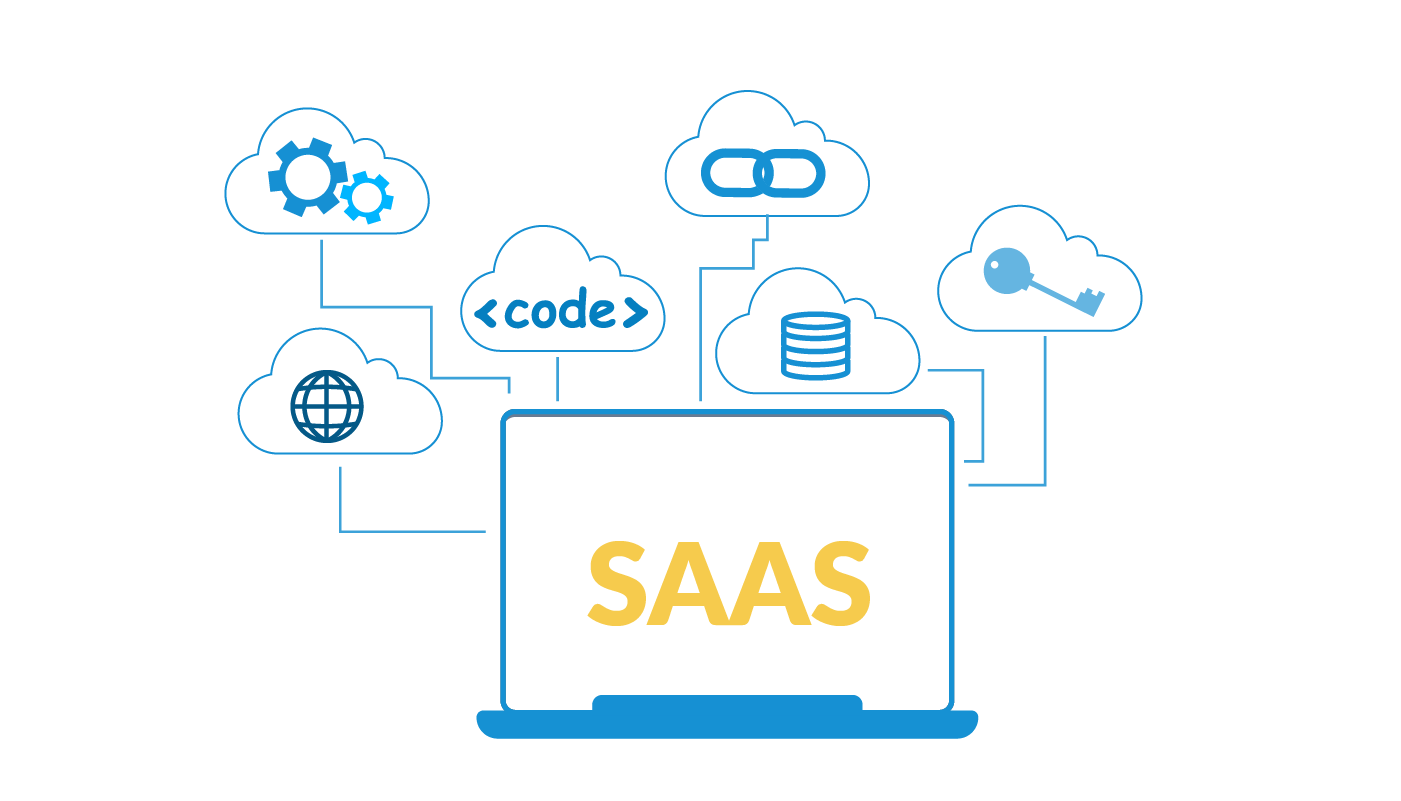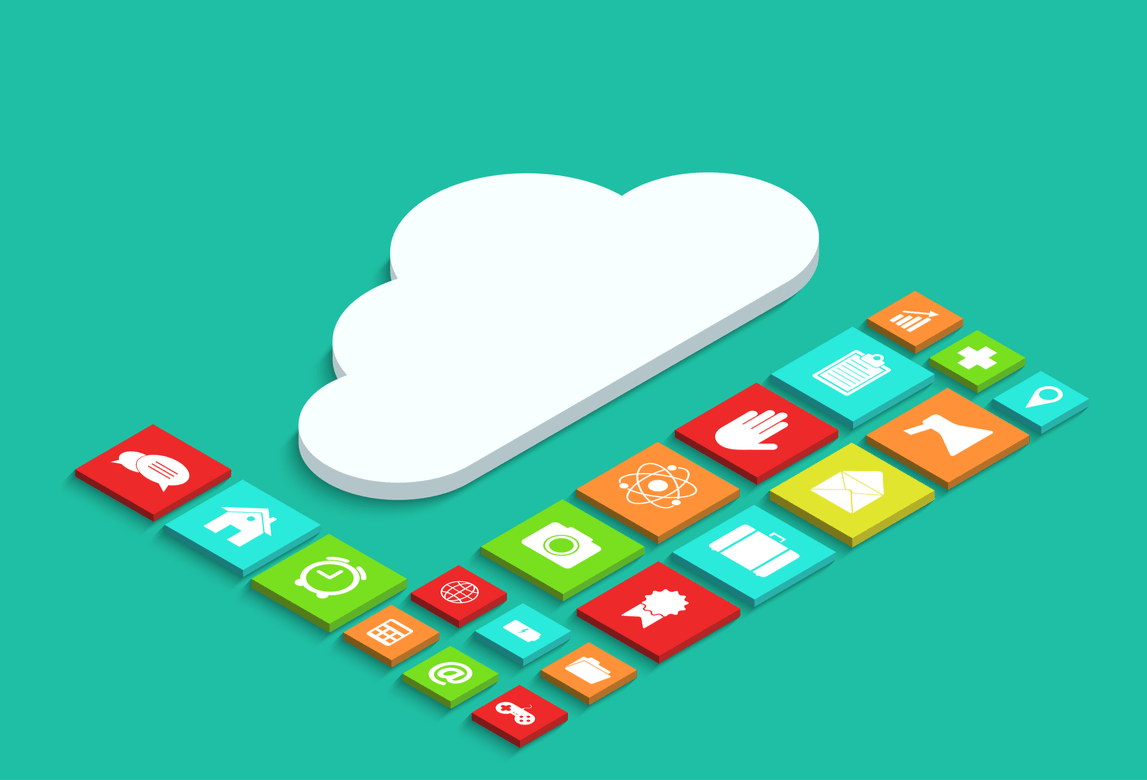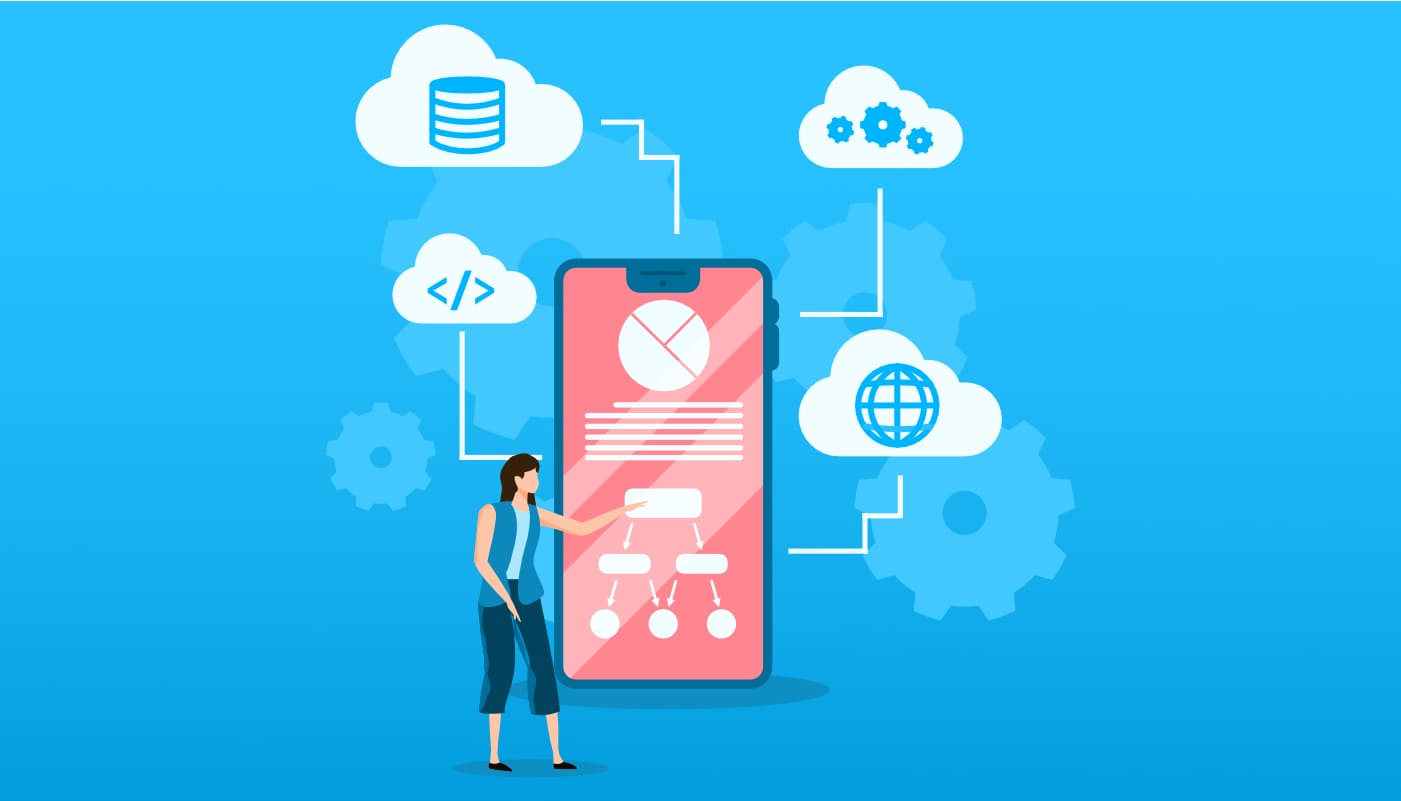If you are still not working on the SaaS platform and haven’t found your “right” business solution, this article is for you! With numerous solutions on the SaaS market via famous cloud providers like Azure and AWS, the worldwide market of software development as a service is expected to rise by 7.33% between 2024 and 2028, reaching a market value of around $ 374.50 billion. This figure is absolutely realistic, as according to Harvey Nash’s Technology research, 73% of leaders across different industries use SaaS solutions to achieve business goals.
Today the limelight of our article is SaaS industry trends 2025 and SaaS opportunities for businesses and personal growth that promise us a better future in terms of improved operational efficiency, profitability, document accessibility, and building personal spaces and websites on no-code development platforms. Sound promising? Then let’s take a look at them one by one to get the most out of SaaS technology trends.
What’s SaaS (Software as a Service)?
Software as a service is a software licensing model that users can access on a subscription basis, with the application located on external servers. More commonly, companies provide SaaS services on hosted platforms.
Let’s take the example of well-known Google Docs from Google Drive Suite to explain to you better what SaaS means. An access to the platform is free of charge and no installations are required to start working with Google applications. The only thing you need is a personal Google account. And the reason why businesses and individuals work with Google Docs is that documents are automatically saved and you don’t have to worry about the loss of information. In other words, Google Docs is a bright example of accessible cloud-based software solutions.
The importance of free and user-friendly cloud storage technologies is constantly growing, and the main point is to get necessary documents and visuals anywhere, anytime, and from any device. Thus, the main advantages of cloud services like Google Docs and Dropbox are:
- Data Accessibility
Users have the flexibility to retrieve their information from anywhere, at any time, and on any device.
- Data Security
By implementing robust encryption protocols, multi-factor authentication, and regular security updates, cloud storage providers ensure that data remains safe from unauthorized access and cyber threats. In 2025, with the rise of data breaches and cyber-attacks, the emphasis on data security has never been more critical, making cloud storage a reliable and secure option for safeguarding sensitive information.
- Scalability
Cloud storage solutions offer the ability to scale storage resources up or down based on demand, providing users with the flexibility to accommodate changing storage needs. If you are looking to expand your data storage capacity, you always have a choice of pre-paid subscription and storage size.
Interestingly, the United States has more SaaS companies than any other country. Both the UK and Canada have 2,000 SaaS companies each. Germany and France each have 1,000 SaaS market players to tie in third. The SaaS industry is constantly evolving, and new SaaS trends make waves across different industries.

Features of the SaaS model
If you still can’t figure out why SaaS is so popular and why your business may require a SaaS solution, let’s check out the main features of this software distribution model one by one.
Working via a web interface
When using SaaS, you need installation files, folders, and documents on your computer. All data is located on the servers of the service provider — in the so-called “cloud” storage on the network. You get remote access to the program and can work with it in a browser from anywhere in the world where there is the Internet.
Automatic Updates
Another standout feature of the SaaS model is the provision of automatic updates, ensuring that users always have access to the latest software enhancements and security patches. Once again, just think of Google Docs, where you automatically see a new feature appear in the document.
Payment for access
SaaS payment models are quite varied. Typically, users pay for access to software on a subscription basis, eliminating the need for upfront investments in software licenses or infrastructure. Nor do they pay high development costs, as when ordering a custom solution. Some SaaS offer a limited set of features for free, and for access to advanced software capabilities, you have to pay a subscription.
Low-Code and No-Code Integration
One of the key advantages of the SaaS model is its support for low-code and no-code integration, allowing users to customize and extend software functionality without the need for extensive programming knowledge. By providing intuitive drag-and-drop interfaces and pre-built components, SaaS platforms empower users to create custom workflows, automate tasks, and integrate with other applications seamlessly.
SaaS Industry Trends 2025
SaaS products are all around us, but what are the most trending SaaS products that can enhance business processes, improve operational efficiency, and meet customer expectations? There is no definite answer to this question because current SaaS market trends are versatile, including the jump into the PaaS and IaaS models that carry out different benefits for different purposes.
At the same time, we can predict the future of SaaS by looking at the recent changes, and use cases, and decide how to move forward.
But first thing first, let’s take a look at what happens with PaaS and IaaS service models and their benefits in 2025. What type of service is better for your business solution?

-
Migration to PaaS (Platform-as-a-Service)
The SaaS market is in high gear of competition that leads companies to look for new ways to improve their products. PaaS is an appealing software distribution model for companies in terms of product development and customer retention. Thus, many of them choose to migrate to scale their products further.
So, what are the key benefits of PaaS? Let’s see:
- PaaS is characterized as a highly scalable, agile, and fast alternative to SaaS.
- For businesses, it’s easy to build custom applications as add-ons to their main to ensure their superior flexibility.
Just as an example, Box and Salesforce, which are worldwide SaaS providers, have recently followed this trend and migrated to PaaS. By doing that, SaaS vendors strive to enhance client retention and increase demand for their services.
-
High Demand for IaaS (Infrastructure as a Service)
Despite the SaaS model being predicted to grow enormously, IaaS also takes a grand market share. In 2023, the market reached $65.95 billion and is projected to hit $558.86 billion by 2032. Meanwhile, North America dominates in the use of the IaaS model with a market share of 44.85%.
What is IaaS? Just imagine, you would like to offer a product or service, but don’t want to spend time and resources buying IT infrastructure equipment and storing all your information locally. The decision is simple – look for an IaaS provider, who gives access to cloud servers, storage, and virtual machines on a pay-as-you-go basis!
Major providers and vendors who benefit from the IaaS model include Amazon (Web Services), Microsoft (Azure), Google (Compute Engine), and Alibaba.
Main benefits include:
- Forget about buying hardware and infrastructure. Pay according to the used resources.
- IaaS providers offer serverless platforms profitable for building applications with high speed and good scalability.
Every service model has its benefits and it’s up to you to choose the best for your business scope. And now let’s see the rest of the opportunities that make a difference in the cloud-service market.
Hybrid Cloud Solutions
A hybrid cloud solution is a promising SaaS market trend in 2025, especially in the healthcare industry. It offers a balance between on-premises infrastructure and cloud services. This approach allows businesses to leverage the scalability and flexibility of the cloud while maintaining control over sensitive data and compliance requirements.
One notable example of healthcare SaaS trends is healthcare providers are increasingly turning to hybrid cloud architectures to securely store and analyse patient data while ensuring compliance with stringent regulatory standards.
Serverless Architecture for B2B SaaS Products
Serverless architecture is revolutionising the way B2B SaaS products are developed and deployed. By abstracting server management and infrastructure concerns, the technology enables companies to focus on building scalable and efficient applications without the burden of managing servers.
A bright example of a B2B SaaS provider is Amazon Web Services (AWS), the powerhouse of cloud computing. Why do so many companies subscribe to AWS? That’s because it offers scalable and flexible cloud infrastructure, storage, computing power, and a plethora of other services. As a result, according to Statista research, AWS generated 90.8 billion US dollars with its cloud services in 2023.
AI Integration & Machine Learning
Artificial intelligence jumps on the bandwagon of fighting cyberattacks. Kevin Skapinets, a Vice President of Strategy and Design at IBM Security, thinks that AI algorithms are helpful in detecting and predicting the common patterns of threats. So, how can Artificial Intelligence be at hand? By implementing this technology, it’s possible to identify malware and ransomware attacks before they enter software system development.
Automation is another advantage of AI in strengthening data security for SaaS. Oracle, a US computer technology giant, applied this trend to its services and expanded one of them — Cloud Access Security Broker. As a result, developers managed to fasten the process of threat detection with AI algorithms. Find a team that possesses solid expertise and hands-on experience to get delivered robust AI services.
SaaS Products for Remote Work
According to TechCrunch, there are many great SaaS tools on the market that might get new usage now as the novel coronavirus outbreak continues to spread into new regions of the world. Let’s mention some software development instruments that will be at your fingertips when you work from home. Need to organize a webinar, conference, or business meeting? By installing Zoho or other SaaS-based products on your device, you’ll manage it without a hitch! With Zoho, you can conduct a 40-minute meeting with 100 participants for free.
White Labelling in SaaS
Another popular SaaS trend is white label which is a partnership in which one company produces a product and the other sells it under its own brand. Each participant in the transaction fulfils their obligations. This format establishes the mass production of consumer goods.
White labeling in SaaS helps entrepreneurs enhance their branding without extra costs on infrastructure or development. Among the popular SaaS white labeling companies, there are:
- Weblium, a website constructor
- AppInstitute platform for app development;
- Flywheel — a web hosting platform.
The Growth of Low-Code Platforms
Low-code is a method of designing and developing applications using intuitive graphical tools and built-in features that reduce traditional (professional) code-writing requirements.
The low-code platform market will continue to evolve in the future. In 2022, its annual growth is estimated at $21.2 billion, which is 40%. A product manager from Zoho Creator, Tejas Gadhia, mentions that most of the productivity tools for employees will be low-code. By the way, low-code platforms are beneficial for developers to create drag-and-drop interfaces and integrations flawlessly. Here are several examples of low-code platforms as a service used by companies to optimize their working operations:
- Kissflow — a SaaS workflow management instrument;
- Mendix — an app development platform;
- Salesforce — a cloud platform computing service that offers CRM solutions.
The Emergence of Vertical SaaS
The vertical SaaS solutions focus on the specific needs of a single industry in contrast to the horizontal SaaS. Salesforce, SAP, Oracle, and many other renowned companies started as horizontal SaaS products. However, they changed their marketing approach and implemented the vertical SaaS model to attract more clients and grow profit.
All business owners realize the importance of positioning their companies as industry leaders. That’s why more and more entrepreneurs are now using a vertical SaaS model, which is more industry-oriented than a horizontal one. Have you heard about Meicai – a Chinese platform as a service that connects vegetable farmers with restaurants? Tiger Global Management and Hillhouse Capital, a US investment firm, gave between $600-800 million to this venture in 2018.
The Rise of Micro SaaS
A micro SaaS is a small instrument developed by one person or a group of people to improve the functionalities of existing micro SaaS products like add-ons, extensions, and so on. So, why is micro SaaS trendy? It helps business owners outpace key competitors and find a unique niche in the market.
The other benefit of micro SaaS products is that they don’t need additional overhead from outside investment companies. Have a look at well-known companies that applied the micro SaaS approach – Grammarly, an online editing tool, and Social Sprout, a social media software instrument. Both of them have $200 million and $111.5 million of total funding respectively, and they still occupy leading positions in their fields.
The Need For API Connections
Businesses seek to provide well-integrated modern solutions to their services without creating a new IT ecosystem. That is why SaaS products must have more APIs to ensure data will be seamlessly integrated with existing IT infrastructure. LITSLINK’s high-end software development follows this approach to provide top-notch SaaS and cloud app platform services.
Daniel Levine, a business partner at Accel, believes that APIs tremendously impact SaaS development as they help ensure high extensibility and seamless integration. Have a look at such SaaS companies like Stripe and Plaid. Stripe, an online payment platform for running businesses online, focused on the API-first approach and generated over $22 billion. Plaid is a platform that connects banking data and accounts with apps. In 2019, the company collected $2.5 billion.
Product-Led Growth (PLD)
It’s a go-to-market tactic that relies on a product to acquire, retain, and engage clients. How can SaaS companies use this approach? They focus on consumer high-in-demand components for their product feature set and ensure hassle-free sign-up that doesn’t require a credit card to set up an account. Mail Chimp, Slack, and Dropbox use this strategy to engage their clients and attract new ones. So, will a product-led growth method be popular in the SaaS market? Sure, it is expected to gather steam soon. Harshi Corp, which specializes in cloud automation infrastructure, successfully applied this trend. With this strategy in mind, the company increased its value to $1.9 billion and gained 45 million downloads.
Mobile-First Approach in SaaS
As the name implies, the mobile-first strategy involves designing a website interface primarily focused on mobile devices. The philosophy behind this approach is that first, a prototype design is created for the smallest screen, and then developers move on to larger displays.
According to the figures from Statista, the number of unique mobile users was 4 billion in 2019. As of January 2021, there were 4.18% unique mobile users and 4.54% active Internet users in the world. The number of mobile users is still increasing, which forces SaaS companies to adapt their services to mobile devices. Dropbox, Skype, and many other renowned companies implemented the mobile-first approach in their business models. Trello, Jira, and Mattermost, well-known SaaS tools for management and communication have mobile versions as well.
The Future Of SaaS and the Role of Emerging Technologies in Shaping SaaS Industry
While we are all happy with the existing SaaS solutions and cloud computing innovations like smart AI integration, the future of the SaaS market is just around the corner. The key idea is to bring the computation and storage closer to the data sources to reduce bandwidth issues. So, what are those emerging technologies to look for on the market?
-
Quantum Computing
With its ability to perform complex calculations at an unprecedented speed, quantum computing as a service (QCaaS) will enable SaaS providers to deliver faster and more efficient services to their customers. This technology will enhance data security, optimize algorithms, and open up new possibilities for innovation in SaaS applications.
-
Edge Computing
Edge Computing is another key technology that will transform the SaaS landscape. By bringing computation and data storage closer to the source of data generation, edge computing minimizes latency and improves the overall performance of SaaS solutions. This advancement will enable real-time processing of data, enhance user experience, and support the growth of IoT devices in the SaaS ecosystem.
-
Decentralized Applications
Decentralized Applications (DApps) based on blockchain technology are gaining momentum in the SaaS industry. These applications operate on a decentralized network, offering increased transparency, security, and data integrity. DApps are not new on the market, as we have already seen the dynamic world of Open Sea (NFTs marketplace) and Inch, an Ethereum-based platform for decentralized exchanges.
By leveraging DApps, SaaS providers can offer their customers enhanced data privacy, secure transactions, and seamless integration with other blockchain-based services.
The adoption of these technologies will not only revolutionize the way SaaS applications are developed and deployed but also pave the way for new business models, revenue streams, and market opportunities in the SaaS industry.
Wrapping Up
Now, you are aware of the SaaS trends in 2025 that companies will definitely use to boost business growth. AI solutions, remote and mobile-first approaches, white labeling, low-code platforms, vertical SaaS, microSaaS, API connections, PaaS, and IaaS may help boost your business and make it more efficient. Catch on to these trends to outpace your competitors, acquire new clients, and generate more revenues!
So, if you seek a reliable technology partner for SaaS development services, contact LITSLINK and our software development experts will gladly help you make your product stand out!




